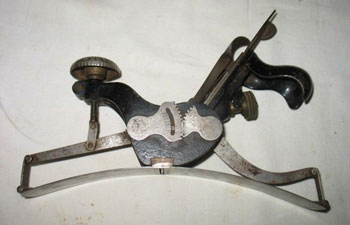Old Tools
by Fishermen’s Voice Staff

Stanley #113 Compass plane. Made for boat building and architectural cabinetry. It can cut both convex and concave pieces. Patented in 1870. This one was made in 1920. Jeff Pearson photo
As the one time wooden ship building capital of America, Maine is a rich source of the metal tools used by the shipwrights who built those wooden ships.
The appeal today of these old tools ranges from the purely visual, to their collectibility to continued practical use. Wooden ships were built before the days of power tools. Those ships required accurately cut and shaped massive timbers and fine details in the captain’s quarters. Unlike a squared off house a ship is built of many compound curved parts. As a result there were many specialized shipbuilding tools.
Jeff Pearson of Searsport buys and sells old tools and specializes in shipbuilding tools.
His collection always has tools that can stump the best of the “what’s this for” experts. He got started in the old tool business when he worked as a shipwright. A Maine native, Pearson worked on a few houses before he signed on to work on the sailing ship Sylvana Beal in Belfast in 1980. That led to work as a shipwright for 16 years at Mystic Seaport in Mystic, Connecticut where among others he helped rebuild the 1841 Charles W. Morgan whaling ship.
For Pearson finding special tools to do the ship building at Mystic Seaport meant going to auctions. And that sometimes that meant buying a complete lot to get one specific tool. Before long he had a lot of tools he didn’t need, so he started selling them.
Caulking mallets are made of hard woods like live oak or black mesquite. Pearson noted that the mallets have a slot in the head that absorb shock and amplify the ring of the caulking mallet. The tone of that ring was used to determine how well the seam was caulked. A thud was not good, the right ring meant a properly caulked seam. Mallets and caulking irons are still used because there is no other way to do the job. A caulker would have a dozen or more caulking irons for different seam widths and for getting at difficult to reach seams where cabin trunks met the deck, etc. In 1996 he decided to sell tools full time and get control of his time as well. He found his way back to Maine at Searsport. A town known at the turn of the 20th century to have had more sea captains than any other town in the nation. It is also home to the Penobscot Marine Museum.
The adze, an axe like tool with the cutting edge turned 90 degrees, is used to shape large timbers among other things. Pearson recalled dubbing – cutting with an adze – a 30 foot long by 10" x 8" timber for the vessel Dunton. A size too unwieldy to run through a band saw. In all, from finding the right tree to felling it, making patterns, dubbing, finishing, and installing, the project took one month. However, crews of experienced shipbuilders turned out enormous ships built with thousands of tons of wood and thousands of wooden parts, outdoors and year round all made with these metal hand tools.
Always willing to talk tools, Jeff Pearson can be reached at 207-322-1186 and rjpearson@snet.net. Pearson sells old tools at shows, including the Maine Boat Builders Show in Portland in March.
